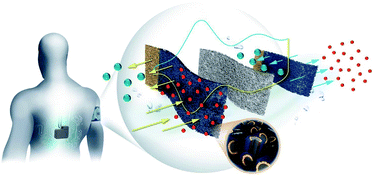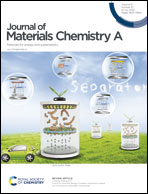A biocompatible open system Na-doped IrOx(OH)y energy storage device with enhanced charge storage properties and long lifetime†
Abstract
Reliability of an energy storage device has been the top requirement for implantable biomedical devices. Conventional implantable batteries have generated serious concerns over their long-term biocompatibility because of potential package corrosion and electrolyte leakage. Here, we demonstrate an open system device using body fluid as the electrolyte that addresses the biocompatibility and reliability issues simultaneously. First, we fabricate Na–IrOx(OH)y biocompatible electrodes by a simple and scalable wet chemical approach. A series of operando measurements were used to establish chemical reactions and structural changes associated with the Na–IrOx(OH)y. An impressive charge storage capacity (1187 C g−1/330 mA h g−1) is achieved by multiple redox reactions, including the proton and Na ion insertion/extraction that reaches > 10 000 cycles in both phosphate buffered saline and L929 cell culture. To validate the biocompatibility of Na–IrOx(OH)y, symmetric full cell devices are fabricated on flexible Au-coated polypropylene micromembranes and operated in a L929 cell solution. The open system device reveals a battery-like capacity of 295 mC cm−2 with an energy density of 3.4 mW h cm−3. In addition, the L929 cells stay alive for over 72 h. The successful demonstration of Na–IrOx(OH)y full cells underscores the potential of developing open system energy storage devices for next-generation implantable power sources.



 Please wait while we load your content...
Please wait while we load your content...